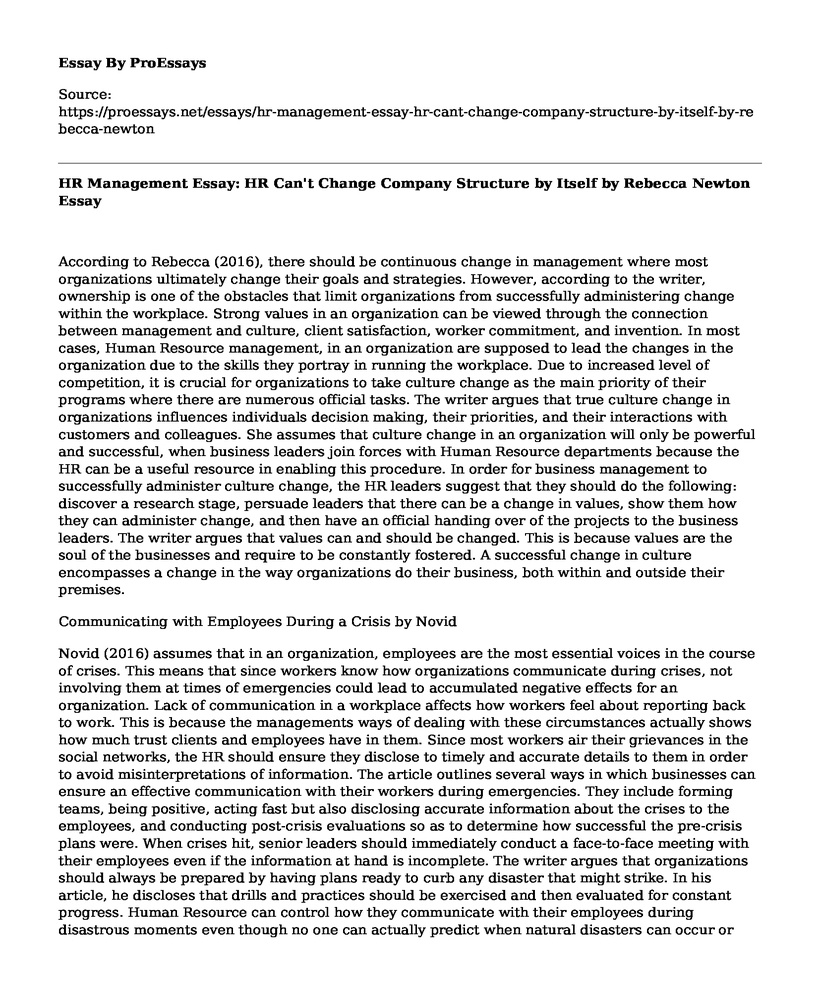According to Rebecca (2016), there should be continuous change in management where most organizations ultimately change their goals and strategies. However, according to the writer, ownership is one of the obstacles that limit organizations from successfully administering change within the workplace. Strong values in an organization can be viewed through the connection between management and culture, client satisfaction, worker commitment, and invention. In most cases, Human Resource management, in an organization are supposed to lead the changes in the organization due to the skills they portray in running the workplace. Due to increased level of competition, it is crucial for organizations to take culture change as the main priority of their programs where there are numerous official tasks. The writer argues that true culture change in organizations influences individuals decision making, their priorities, and their interactions with customers and colleagues. She assumes that culture change in an organization will only be powerful and successful, when business leaders join forces with Human Resource departments because the HR can be a useful resource in enabling this procedure. In order for business management to successfully administer culture change, the HR leaders suggest that they should do the following: discover a research stage, persuade leaders that there can be a change in values, show them how they can administer change, and then have an official handing over of the projects to the business leaders. The writer argues that values can and should be changed. This is because values are the soul of the businesses and require to be constantly fostered. A successful change in culture encompasses a change in the way organizations do their business, both within and outside their premises.
Communicating with Employees During a Crisis by Novid
Novid (2016) assumes that in an organization, employees are the most essential voices in the course of crises. This means that since workers know how organizations communicate during crises, not involving them at times of emergencies could lead to accumulated negative effects for an organization. Lack of communication in a workplace affects how workers feel about reporting back to work. This is because the managements ways of dealing with these circumstances actually shows how much trust clients and employees have in them. Since most workers air their grievances in the social networks, the HR should ensure they disclose to timely and accurate details to them in order to avoid misinterpretations of information. The article outlines several ways in which businesses can ensure an effective communication with their workers during emergencies. They include forming teams, being positive, acting fast but also disclosing accurate information about the crises to the employees, and conducting post-crisis evaluations so as to determine how successful the pre-crisis plans were. When crises hit, senior leaders should immediately conduct a face-to-face meeting with their employees even if the information at hand is incomplete. The writer argues that organizations should always be prepared by having plans ready to curb any disaster that might strike. In his article, he discloses that drills and practices should be exercised and then evaluated for constant progress. Human Resource can control how they communicate with their employees during disastrous moments even though no one can actually predict when natural disasters can occur or when there may be a malfunctioned product. In order for Human Resource to provide more operative emergency communications with employees, they can formulate statements that would help retain calmness among workers as they gather more information. They can also try to focus on the positive side of the crises.
References
Rebecca, N. (2016). HR Can't Change Company Culture by Itself. Retrieved from
https://hbr.org/2016/hr-cant-change-company-culture-by-itselfNovid, P. (2016). Communicating with Employees during a Crisis. Retrieved from
https://www/shrm.org/hr-today/news/hr-magazine/1116/pages/communicating-with-empl...
Cite this page
HR Management Essay: HR Can't Change Company Structure by Itself by Rebecca Newton. (2021, Mar 29). Retrieved from https://proessays.net/essays/hr-management-essay-hr-cant-change-company-structure-by-itself-by-rebecca-newton
If you are the original author of this essay and no longer wish to have it published on the ProEssays website, please click below to request its removal:
- Reflective Essay Example: Team Management
- Four Factors of Production in the Ecosystem - Paper Example
- Carol's Leadership Traits Analysis Paper Example
- The Concept of CSR Paper Example
- Annotated Bibliography on American Federation of Labor
- Strengthening Household Appliances Supply Chain Risk Management - Essay Sample
- Essay on OpenHAB Amazon Alexa Project: Uncovering Smart Home Security







